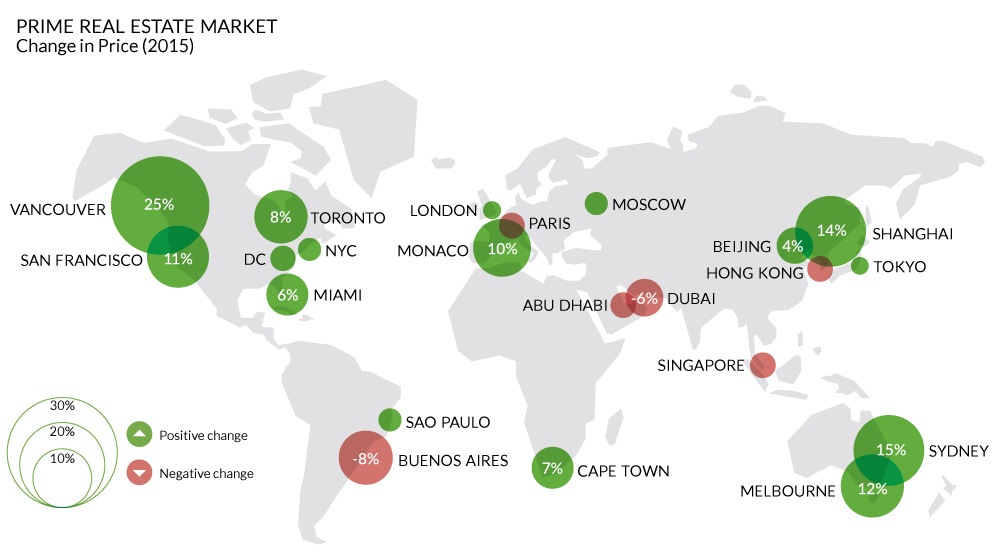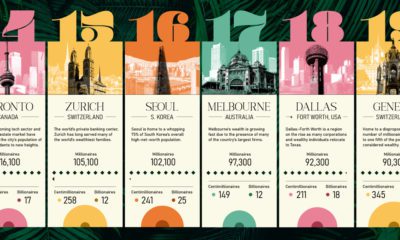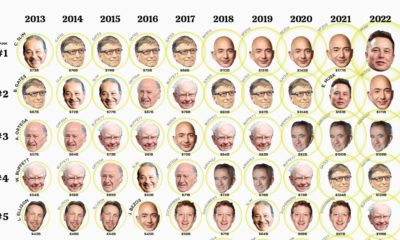The global market for high-end luxury properties is a volatile one. For example, during the tumultuous year of 2009, there was an astonishing 97 percentage point differential in the price changes of high-end real estate. Some markets may have been up 30%, but others were down over 60% – that’s a wild margin for multi-million dollar properties in some of the most world-class cities in the world. This is according to the latest iteration of the Wealth Report, an annual publication by the global real estate consultancy Knight Frank that focuses on the world’s ultra-rich.
High-end Real Estate in 2015
The market for luxury properties last year was obviously less volatile than the aforementioned example, however the spread is still significant. In Vancouver, which is currently engulfed in a real estate mania that we covered in-depth yesterday, luxury properties jumped up in price by 25% throughout 2015. This is not an exception to the trend. Royal Lepage, another realtor, covered Canadian luxury markets in more depth, finding that properties increased in price by a total of 125% from 2005 to 2015. That compares to 69% increases in Toronto over the same period, and 58% increases in Montreal. The biggest decrease in the price of luxury real estate was in Lagos, Nigeria. The African metropolis of 16 million is the continent’s largest city, as well as the fastest growing city in the world. There, high-end properties divebombed by -20%. In terms of more so-called “world-class” cities, the “Paris of South America” – Buenos Aires – saw the largest decline of -8.0%. Knight Frank notes this decline is based mainly because of currency and affordability issues. The market there could be an interesting one to watch for awhile, as new Argentinian president Mauricio Macri recently took the country’s reins in December 2015.
The North American Market
San Francisco was a distant second place from Vancouver, with an increase in high-end property values of 10.9%. Toronto was up 8.0%, while Los Angeles and New York both held modest gains of 4.7% and 2.4% respectively. Chicago was the worst performing North American city in Knight Frank’s index with a 0.0% price change in luxury properties throughout 2015. on The good news is that the Federal Reserve, U.S. Treasury, and Federal Deposit Insurance Corporation are taking action to restore confidence and take the appropriate measures to help provide stability in the market. With this in mind, the above infographic from New York Life Investments looks at the factors that impact bonds, how different types of bonds have historically performed across market environments, and the current bond market volatility in a broader context.
Bond Market Returns
Bonds had a historic year in 2022, posting one of the worst returns ever recorded. As interest rates rose at the fastest pace in 40 years, it pushed bond prices lower due to their inverse relationship. In a rare year, bonds dropped 13%.
Source: FactSet, 01/02/2023.
Bond prices are only one part of a bond’s total return—the other looks at the income a bond provides. As interest rates have increased in the last year, it has driven higher bond yields in 2023.
Source: YCharts, 3/20/2023.
With this recent performance in mind, let’s look at some other key factors that impact the bond market.
Factors Impacting Bond Markets
Interest rates play a central role in bond market dynamics. This is because they affect a bond’s price. When rates are rising, existing bonds with lower rates are less valuable and prices decline. When rates are dropping, existing bonds with higher rates are more valuable and their prices rise. In March, the Federal Reserve raised rates 25 basis points to fall within the 4.75%-5.00% range, a level not seen since September 2007. Here are projections for where the federal funds rate is headed in 2023:
Federal Reserve Projection*: 5.1% Economist Projections**: 5.3%
*Based on median estimates in the March summary of quarterly economic projections.**Projections based on March 10-15 Bloomberg economist survey. Together, interest rates and the macroenvironment can have a positive or negative effect on bonds.
Positive
Here are three variables that may affect bond prices in a positive direction:
Lower Inflation: Reduces likelihood of interest rate hikes. Lower Interest Rates: When rates are falling, bond prices are typically higher. Recession: Can prompt a cut in interest rates, boosting bond prices.
Negative
On the other hand, here are variables that may negatively impact bond prices:
Higher Inflation: Can increase the likelihood of the Federal Reserve to raise interest rates. Rising Interest Rates: Interest rate hikes lead bond prices to fall. Weaker Fundamentals: When a bond’s credit risk gets worse, its price can drop. Credit risk indicates the chance of a default, the risk of a bond issuer not making interest payments within a given time period.
Bonds have been impacted by these negative factors since inflation started rising in March 2021.
Fixed Income Opportunities
Below, we show the types of bonds that have had the best performance during rising rates and recessions.
Source: Derek Horstmeyer, George Mason University 12/3/2022. As we can see, U.S. ultrashort bonds performed the best during rising rates. Mortgage bonds outperformed during recessions, averaging 11.4% returns, but with higher volatility. U.S. long-term bonds had 7.7% average returns, the best across all market conditions. In fact, they were also a close second during recessions. When rates are rising, ultrashort bonds allow investors to capture higher rates when they mature, often with lower historical volatility.
A Closer Look at Bond Market Volatility
While bond market volatility has jumped this year, current dislocations may provide investment opportunities. Bond dislocations allow investors to buy at lower prices, factoring in that the fundamental quality of the bond remains strong. With this in mind, here are two areas of the bond market that may provide opportunities for investors:
Investment-Grade Corporate Bonds: Higher credit quality makes them potentially less vulnerable to increasing interest rates. Intermediate Bonds (2-10 Years): Allow investors to lock in higher rates.
Both types of bonds focus on quality and capturing higher yields when faced with challenging market conditions.
Finding the Upside
Much of the volatility seen in the banking sector was due to banks buying bonds during the pandemic—or even earlier—at a time when interest rates were historically low. Since then, rates have climbed considerably. Should rates moderate or stop increasing, this may present better market conditions for bonds. In this way, today’s steep discount in bond markets may present an attractive opportunity for price appreciation. At the same time, investors can potentially lock in strong yields as inflation may subside in the coming years ahead. Learn more about bond investing strategies with New York Life Investments.




























